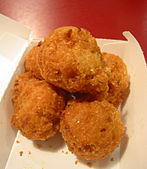
This is a list of American breads. Bread is a staple food prepared from a dough of flour and water, usually by baking. Throughout recorded history it has been popular around the world and is one of humanity's oldest foods, having been of importance since the dawn of agriculture.
Contents
This list includes breads that originated in the United States.







